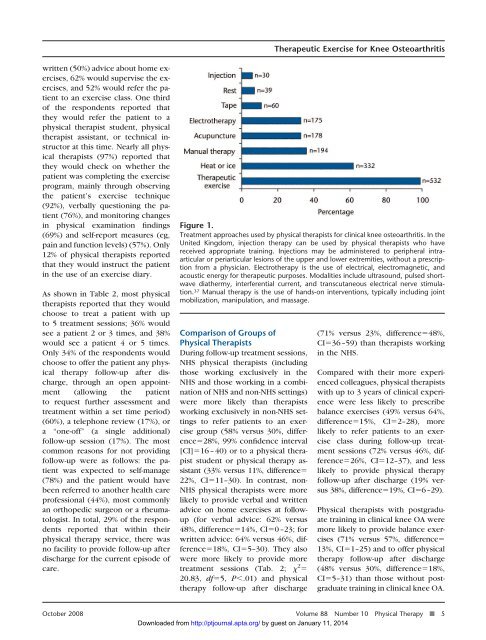Physical Therapists' Use of Therapeutic Exercise for Patients With ...
Physical Therapists' Use of Therapeutic Exercise for Patients With ...
Physical Therapists' Use of Therapeutic Exercise for Patients With ...
You also want an ePaper? Increase the reach of your titles
YUMPU automatically turns print PDFs into web optimized ePapers that Google loves.
<strong>Therapeutic</strong> <strong>Exercise</strong> <strong>for</strong> Knee Osteoarthritis<br />
written (50%) advice about home exercises,<br />
62% would supervise the exercises,<br />
and 52% would refer the patient<br />
to an exercise class. One third<br />
<strong>of</strong> the respondents reported that<br />
they would refer the patient to a<br />
physical therapist student, physical<br />
therapist assistant, or technical instructor<br />
at this time. Nearly all physical<br />
therapists (97%) reported that<br />
they would check on whether the<br />
patient was completing the exercise<br />
program, mainly through observing<br />
the patient’s exercise technique<br />
(92%), verbally questioning the patient<br />
(76%), and monitoring changes<br />
in physical examination findings<br />
(69%) and self-report measures (eg,<br />
pain and function levels) (57%). Only<br />
12% <strong>of</strong> physical therapists reported<br />
that they would instruct the patient<br />
in the use <strong>of</strong> an exercise diary.<br />
As shown in Table 2, most physical<br />
therapists reported that they would<br />
choose to treat a patient with up<br />
to 5 treatment sessions; 36% would<br />
see a patient 2 or 3 times, and 38%<br />
would see a patient 4 or 5 times.<br />
Only 34% <strong>of</strong> the respondents would<br />
choose to <strong>of</strong>fer the patient any physical<br />
therapy follow-up after discharge,<br />
through an open appointment<br />
(allowing the patient<br />
to request further assessment and<br />
treatment within a set time period)<br />
(60%), a telephone review (17%), or<br />
a “one-<strong>of</strong>f” (a single additional)<br />
follow-up session (17%). The most<br />
common reasons <strong>for</strong> not providing<br />
follow-up were as follows: the patient<br />
was expected to self-manage<br />
(78%) and the patient would have<br />
been referred to another health care<br />
pr<strong>of</strong>essional (44%), most commonly<br />
an orthopedic surgeon or a rheumatologist.<br />
In total, 29% <strong>of</strong> the respondents<br />
reported that within their<br />
physical therapy service, there was<br />
no facility to provide follow-up after<br />
discharge <strong>for</strong> the current episode <strong>of</strong><br />
care.<br />
Figure 1.<br />
Treatment approaches used by physical therapists <strong>for</strong> clinical knee osteoarthritis. In the<br />
United Kingdom, injection therapy can be used by physical therapists who have<br />
received appropriate training. Injections may be administered to peripheral intraarticular<br />
or periarticular lesions <strong>of</strong> the upper and lower extremities, without a prescription<br />
from a physician. Electrotherapy is the use <strong>of</strong> electrical, electromagnetic, and<br />
acoustic energy <strong>for</strong> therapeutic purposes. Modalities include ultrasound, pulsed shortwave<br />
diathermy, interferential current, and transcutaneous electrical nerve stimulation.<br />
37 Manual therapy is the use <strong>of</strong> hands-on interventions, typically including joint<br />
mobilization, manipulation, and massage.<br />
Comparison <strong>of</strong> Groups <strong>of</strong><br />
<strong>Physical</strong> Therapists<br />
During follow-up treatment sessions,<br />
NHS physical therapists (including<br />
those working exclusively in the<br />
NHS and those working in a combination<br />
<strong>of</strong> NHS and non-NHS settings)<br />
were more likely than therapists<br />
working exclusively in non-NHS settings<br />
to refer patients to an exercise<br />
group (58% versus 30%, difference28%,<br />
99% confidence interval<br />
[CI]16–40) or to a physical therapist<br />
student or physical therapy assistant<br />
(33% versus 11%, difference<br />
22%, CI11–30). In contrast, non-<br />
NHS physical therapists were more<br />
likely to provide verbal and written<br />
advice on home exercises at followup<br />
(<strong>for</strong> verbal advice: 62% versus<br />
48%, difference14%, CI0–23; <strong>for</strong><br />
written advice: 64% versus 46%, difference18%,<br />
CI5–30). They also<br />
were more likely to provide more<br />
treatment sessions (Tab. 2; 2 <br />
20.83, df5, P.01) and physical<br />
therapy follow-up after discharge<br />
(71% versus 23%, difference48%,<br />
CI36–59) than therapists working<br />
in the NHS.<br />
Compared with their more experienced<br />
colleagues, physical therapists<br />
with up to 3 years <strong>of</strong> clinical experience<br />
were less likely to prescribe<br />
balance exercises (49% versus 64%,<br />
difference15%, CI2–28), more<br />
likely to refer patients to an exercise<br />
class during follow-up treatment<br />
sessions (72% versus 46%, difference26%,<br />
CI12–37), and less<br />
likely to provide physical therapy<br />
follow-up after discharge (19% versus<br />
38%, difference19%, CI6–29).<br />
<strong>Physical</strong> therapists with postgraduate<br />
training in clinical knee OA were<br />
more likely to provide balance exercises<br />
(71% versus 57%, difference<br />
13%, CI1–25) and to <strong>of</strong>fer physical<br />
therapy follow-up after discharge<br />
(48% versus 30%, difference18%,<br />
CI5–31) than those without postgraduate<br />
training in clinical knee OA.<br />
October 2008 Volume 88 Number 10 <strong>Physical</strong> Therapy f 5<br />
Downloaded from http://ptjournal.apta.org/ by guest on January 11, 2014
















